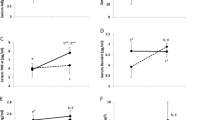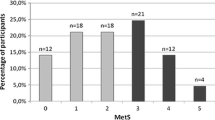Abstract
Regular physical activity (PA) has been associated with decreased risk of many chronic diseases and increased longevity among older adults. In addition, ageing has been associated with higher levels of different inflammatory biomarkers while the association between inflammatory biomarkers and PA has remained controversial. The aim of the current investigation was to examine the association between blood biomarkers and objectively assessed PA among a sample of healthy older women with different levels of PA engagement. A total of 81 healthy women were recruited. Study participants were allocated to three groups according to accelerometer-obtained PA data. Body composition was assessed with dual-energy X-ray absorptiometry. Fasting blood samples were collected for the measurement of resistin, leptin, tumour necrosis factor alpha (TNFα) and C-reactive protein (CRP) concentrations. There were no significant differences between groups for resistin, leptin, TNFα and for CRP concentrations; however, higher moderate-to-vigorous physical activity (MVPA) groups tended to have lower level of blood biomarker concentrations. There was a significant negative relationship between resistin and steps per day. Inverse association between leptin and MVPA was significant after controlling for age. In multivariate stepwise linear regression analysis, steps per day were the strongest independent predictor for resistin, whereas for leptin, TNFα and CRP the strongest independent predictor was whole body fat mass. In conclusion, this study demonstrated negative association between resistin concentration and steps per day. Sedentary time and light PA had no relationship with resistin, leptin, TNFα or CRP concentrations.

Similar content being viewed by others

References
Lana A, Valdés-Bécares A, Buño A et al (2017) Serum leptin concentration is associated with incident frailty in older adults. Aging Dis 8:240–249
Rava A, Pihlak A, Kums T et al (2018) Associations of distinct levels of physical activity with mobility in independent healthy older women. Exp Gerontol 110:209–215. https://doi.org/10.1016/j.exger.2018.06.005
McPhee JS, French DP, Jackson D et al (2016) Physical activity in older age: perspectives for healthy ageing and frailty. Biogerontology 17:567–580
Lee IM, Shiroma EJ, Lobelo F et al (2012) Effect of physical inactivity on major non-communicable diseases worldwide: an analysis of burden of disease and life expectancy. Lancet 380:219–229. https://doi.org/10.1016/S0140-6736(12)61031-9
Maltais ML, Desroches J, Dionne IJ (2009) Changes in muscle mass and strength after menopause. J Musculoskelet Neuronal Interact 9:186–197
Toth MJ, Tchernof A, Sites CK et al (2000) Menopause-related changes in body fat distribution. Ann N Y Acad Sci 904:502–506
Lachman S, Boekholdt SM, Luben RN et al (2018) Impact of physical activity on the risk of cardiovascular disease in middle-aged and older adults: EPIC Norfolk prospective population study. Eur J Prev Cardiol 25:200–208. https://doi.org/10.1177/2047487317737628
Higueras-Fresnillo S, Guallar-Castillón P, Cabanas-Sanchez V et al (2017) Changes in physical activity and cardiovascular mortality in older adults. J Geriatr Cardiol 14:280–281
Hirvensalo M, Rantanen T, Heikkinen E (2000) Mobility difficulties and physical activity as predictors of mortality and loss of independence in the community-living older population. J Am Geriatr Soc 48:493–498
Hupin D, Roche F, Gremeaux V et al (2015) Even a low-dose of moderate-to-vigorous physical activity reduces mortality by 22% in adults aged ≥ 60 years: a systematic review and meta-analysis. Br J Sports Med 49:1262–1267
Sallam N, Laher I (2016) Exercise modulates oxidative stress and inflammation in aging and cardiovascular diseases. Oxid Med Cell Longev. https://doi.org/10.1155/2016/723963
Colbert LH, Visser M, Simonsick EM et al (2004) Physical activity, exercise, and inflammatory markers in older adults: findings from the Health, Aging and Body Composition Study. J Am Geriatr Soc 52:1098–1104
Geffken DF, Cushman M, Burke GL et al (2001) Association between physical activity and markers of inflammation in a healthy elderly population. Am J Epidemiol 153:242–250
Tracy RP, Lemaitre RN, Psaty BM et al (1997) Relationship of C-reactive protein to risk of cardiovascular disease in the elderly. Results from the cardiovascular health study and the rural health promotion project. Arterioscler Thromb Vasc Biol 17:1121–1127
Pacifici R (1996) Estrogen, cytokines, and pathogenesis of postmenopausal osteoporosis. J Bone Miner Res 11:1043–1051
Kennedy BK, Berger SL, Brunet A et al (2014) Aging: a common driver of chronic diseases and a target for novel interventions. Cell 159:709–713. https://doi.org/10.1016/j.cell.2014.10.039
Reilly MP, Lehrke M, Wolfe ML et al (2005) Resistin is an inflammatory marker of atherosclerosis in humans. Circulation 111:932–939
Marcelino-Rodríguez I, Almeida Gonzalez D, Alemán-Sánchez JJ et al (2017) Inverse association of resistin with physical activity in the general population. PLoS ONE 12:e0182493. https://doi.org/10.1371/journal.pone.0182493
Suragani M, Aadinarayana VD, Pinjari AB et al (2013) Human resistin, a proinflammatory cytokine, shows chaperone-like activity. Proc Natl Acad Sci USA 110:20467–20472. https://doi.org/10.1073/pnas.1306145110
Qatanani M, Szwergold NR, Greaves DR et al (2009) Macrophage-derived human resistin exacerbates adipose tissue inflammation and insulin resistance in mice. J Clin Invest 119:531–539
Lou J, Huang L, Wang A et al (2018) Resistin-induced endoplasmic reticulum stress contributes to the impairment of insulin signaling in endothelium. Front Pharmacol 9:1226
Alissa EM, Alzughaibi LS, Marzouki ZM (2019) Association between serum resistin, adiposity measures and inflammatory makers in women without cardiovascular diseases. Chem Phys Lipids 218:136–140. https://doi.org/10.1016/j.chemphyslip.2018.12.005
Jones TE, Basilio JL, Brophy PM et al (2009) Long-term exercise training in over- weight adolescents improves plasma peptide YY and resistin. Obesity 17:1189–1195
Prestes J, Shiguemoto G, Botero JP et al (2009) Effects of resistance training on resistin, leptin, cytokines, and muscle force in elderly post-menopausal women. J Sports Sci 27:1607–1615. https://doi.org/10.1080/02640410903352923
Giannopoulou I, Fernhall B, Carhart R et al (2005) Effects of diet and/or exercise on the adipocytokine and inflammatory cytokine levels of postmenopausal women with type 2 diabetes. Metabolism 54:866–875
Mishra S, Harris TB, Hsueh WC et al (2015) The association of serum leptin with mortality in older adults. PLoS ONE 10:e0140763. https://doi.org/10.1371/journal.pone.0140763
Alessa HB, Chomistek AK, Hankinson SE et al (2017) Objective measures of physical activity and cardiometabolic and endocrine biomarkers. Med Sci Sports Exerc 49:1817–1825. https://doi.org/10.1249/MSS.0000000000001287
Rava A, Pihlak A, Ereline J et al (2017) Body composition, neuromuscular performance, and mobility: comparison between regularly exercising and inactive older women. J Aging Phys Act 25:58–64. https://doi.org/10.1123/japa.2016-0019
Vaitkevičiūtė D, Lätt E, Mäestu J et al (2014) Physical activity and bone mineral accrual in boys with different body composition parameters during puberty: a longitudinal study. PLoS ONE 9:e107759
Jürimäe J, Kums T, Jürimäe T (2010) Plasma adiponectin concentration is associated with the average accelerometer daily steps counts in healthy elderly females. Eur J Appl Physiol 109:823–828
Foong YC, Chherawala N, Aitken D et al (2016) Accelerometer-determined physical activity, muscle mass, and leg strength in community-dwelling older adults. J Cachexia Sarcopenia Muscle 7:275–283
Johansson J, Nordström A, Nordström P (2015) Objectively measured physical activity is associated with parameters of bone in 70-year-old men and women. Bone 81:72–79
Gorman E, Hanson HM, Yang PH et al (2014) Accelerometry analysis of physical activity and sedentary behavior in older adults: a systematic review and data analysis. Eur Rev Aging Phys Act 11:35–49. https://doi.org/10.1007/s11556-013-0132-x
Loprinzi PD, Lee H, Cardinal BJ (2015) Evidence to support including lifestyle light intensity recommendations in physical activity guidelines for older adults. Am J Health Promot 29:277–284
Gennuso KP, Gangnon RE, Matthews CE et al (2013) Sedentary behavior, physical activity, and markers of health in older adults. Med Sci Sports Exerc 45:1493–1500
Hansen BH, Kolle E, Dyrstad SM et al (2012) Accelerometerdetermined physical activity in adults and older people. Med Sci Sports Exerc 44:266–272
Dohrn IM, Hagströmer M, Hellenius ML et al (2016) Gait speed, quality of life, and sedentary time are associated with steps per day in community-dwelling older adults with osteoporosis. J Aging Phys Act 24:22–31
Bucci L, Yani SL, Fabbri C et al (2013) Circulating levels of adipokines and IGF-1 are associated with skeletal muscle strength of young and old healthy subjects. Biogerontology 14:261–272. https://doi.org/10.1007/s10522-013-9428-5
Tudor-Locke C, Schuna JM Jr, Barreira TV et al (2013) Normative steps/day values for older adults: NHANES 2005-2006. J Gerontol A Biol Sci Med Sci 68:1426–1432. https://doi.org/10.1093/gerona/glt116
Gonzales JU, Shephard J, Dubey N (2015) Steps per day, daily peak stepping cadence, and walking performance in older adults. J Aging Phys Act 23:395–400. https://doi.org/10.1123/japa.2014-0049
Yamamoto N, Miyazaki H, Shimada M et al (2018) Daily step count and all-cause mortality in a sample of Japanese elderly people: a cohort study. BMC Public Health 18:540. https://doi.org/10.1186/s12889-018-5434-5
World Health Organization (2011) Global recommendations on physical activity for health. World Health Organization, Geneva
Tudor-Locke C, Craig CL, Aoyagi Y et al (2011) How many steps/day are enough? For older adults and special populations. Int J Behav Nutr Phys Act 8:80. https://doi.org/10.1186/1479-5868-8-80
Gencer B, Auer R, de Rekeneire N et al (2016) Association between resistin levels and cardiovascular disease events in older adults: the health, aging and body composition study. Atherosclerosis 245:181–186
Bouassida A, Zalleg D, Bouassida S et al (2006) Leptin, its implication in physical exercise and training: a short review. J Sports Sci Med 5:172–181
Wu SH, Shu XO, Chow WH et al (2014) Nonexercise physical activity and inflammatory and oxidative stress markers in women. J Womens Health (Larchmt) 23:159–167
Monteiro-Junior RS, de Tarso Maciel-Pinheiro P, da Matta Mello Portugal E et al (2018) Effect of exercise on inflammatory profile of older persons: systematic review and meta-analyses. J Phys Act Health 15:64–71. https://doi.org/10.1123/jpah.2016-0735
Funding
This study was funded by the Estonian Ministry of Education and Science Project No. IUT 20-58.
Author information
Authors and Affiliations
Corresponding author
Ethics declarations
Conflict of interest
The authors declare that they have no conflict of interest.
Ethical approval
All procedures performed in studies involving human participants were in accordance with the ethical standards of the institutional and/or national research committee and with the 1964 Helsinki declaration and its later amendments or comparable ethical standards.
Informed consent
Informed consent was obtained from all individual participants included in the study.
Additional information
Publisher's Note
Springer Nature remains neutral with regard to jurisdictional claims in published maps and institutional affiliations.
Rights and permissions
About this article
Cite this article
Rava, A., Pihlak, A., Kums, T. et al. Resistin concentration is inversely associated with objectively measured physical activity in healthy older women. Aging Clin Exp Res 32, 475–481 (2020). https://doi.org/10.1007/s40520-019-01222-6
Received:
Accepted:
Published:
Issue Date:
DOI: https://doi.org/10.1007/s40520-019-01222-6



